[/caption]
Another end-of-an-era event heralding the conclusion of the space shuttle program: the final set of space shuttle solid rocket booster segments arrived at the Kennedy Space Center on Thursday, May 27, 2010. The segments were carried on railway cars from the ATK factory in Utah where the boosters are built. The last part of the trip from Jacksonville, Florida included passenger cars carrying NASA personnel and ATK officials, including astronaut Mike Massimino, shuttle launch director Mike Leinbach, and the “voice” of NASA TV, George Diller. The train stopped across the Indian River from KSC where the tracks lead to the Vehicle Assembly Building.
The boosters will be stacked in the VAB for a possible rescue mission, or perhaps, even one last add-on flight for space shuttle Atlantis.
The SRB segments are designated for STS-335, the Launch-On-Need mission that would be flown if the last scheduled shuttle flight — STS-134, now scheduled for launch in late November — would encounter a problem. Or, if Congress allows, another shuttle mission using the ready-to-go shuttle could be added. U.S. Sen. Bill Nelson told President Obama in a letter this week that he intended to request funding for the extra mission. NASA hopes to get a go-ahead for the flight, which would become the STS-135 mission, by late June. If approved, the likely launch date would be sometime in the summer of 2011.
NASA’s Associate Administrator for Space Operations Bill Gerstenmaier said at a news conference this week that if the additional flight were approved, a Soyuz would be readied as a rescue vehicle, and the shuttle crew would be smaller, probably 4 crew members. The crew could take safe harbor at the International Space Station, if needed, until the rescue Soyuz arrived. The shuttle could bring extra supplies and hardware to the ISS.

Veteran astronaut Mike Massimino told a Florida television station crew that he hopes for an additional shuttle mission. “I think we have to be optimistic,” Massimino said. “There are just too many people around the country and the world who are so supportive of our program.”
ATK laid off 1,300 of their 5,000 person workforce because of shutting down production of the boosters, but the company is hoping to be part of NASA’s future spaceflight plans.
“There’s quite a bit of uncertainty,” said ATK KSC Deputy Director Ted Shaffner. “The direction is very cloudy from our politicians and NASA is struggling with what direction we do take.”
More images from the event:
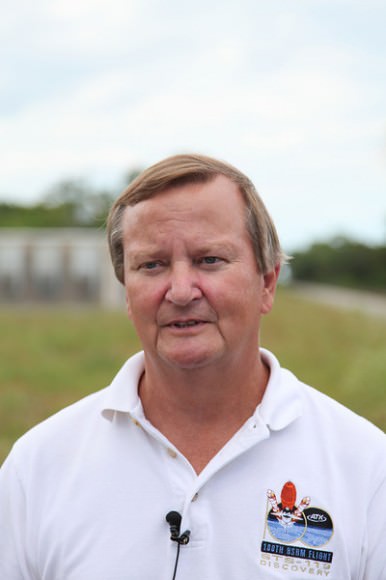
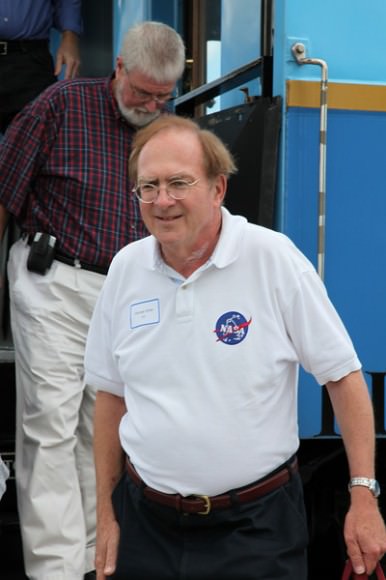
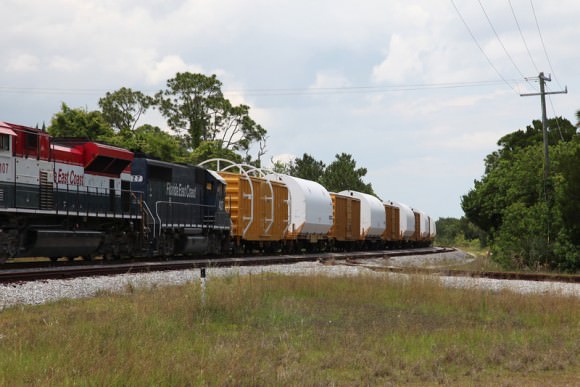
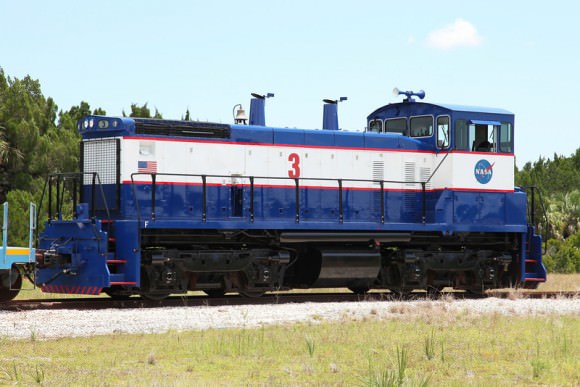
And I know someone is going to comment on the “Do Not Hump” sign on the railcar. What it means is that the contents of the railcar are delicate enough that the car should not be ‘humped,’ which is a method to sort freight cars by rolling them down a hill instead of using a locomotive engine to move the cars. Obviously, NASA and ATK don’t want the SRB segments to go rolling down a hill. Find out more about humping here.
Sources: Florida Today, CFNews 13

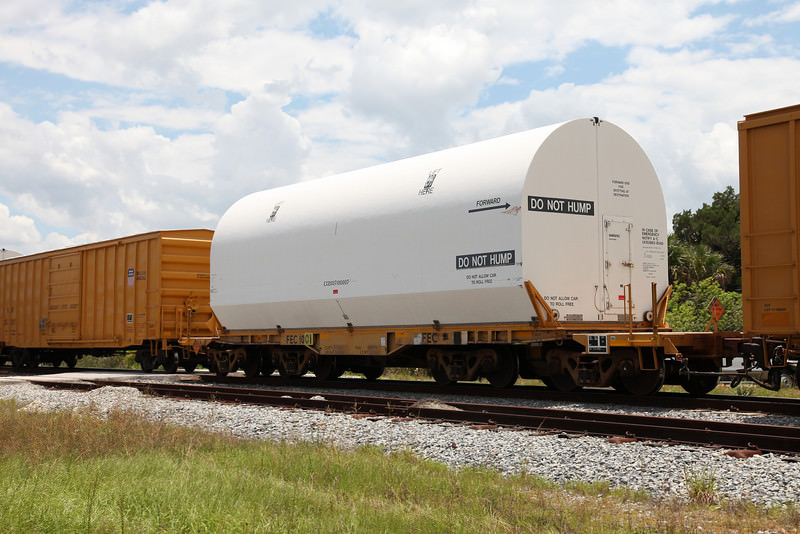
End of an era…?
Am curious about the rail car behind the locomotive in the 5th image… looks like a frame set up to catch/break off overhanging vegetation?
LOL at the last paragraph, you know your readers well Nancy.
I didn’t even know NASA had a train. Looks mighty cool plus the “DO NOT HUMP” or will explode sky high labels are like something I would wear on a t-shirt.
A wild Chihuahua-dog becomes aroused by the sight of the white crate and runs towards it….A few moments later, it explodes in a fiery white cloud.
Time to put away the candlestick firework and start to use rocket engines again.
LOL, so US train workers are people who go hump in the night?!
To quote Armageddon (the most scientifically accurate space exploration movie …ever!):
Col. Sharp: “please get off the solid rocket motor”
Rockhound: “I just wanted to feel the power between my legs, brother”.
Are these the SRBs whose size is defined by the size of two Roman War Horses?
It may not be true but it is a good story.
‘ passenger cars carrying NASA personal and ATK officials’ Personal what?? Perhaps it should be ‘personnel’?
Wow, thank you, I didn’t realize that the story behind the standard rail gauge was a good, nay even better, one:
“Early origins of the standard gauge
There is an urban legend that Julius Caesar specified a legal width for chariots at the width of standard gauge, causing road ruts at that width, so all later wagons had to have the same width or else risk having one set of wheels suddenly fall into one deep rut but not the other.[2] [3]
In fact, the origins of the standard gauge considerably predate the Roman Empire, and may even predate the invention of the wheel. The width of prehistoric vehicles was determined by number of interacting factors which gave rise to a fairly standard vehicle width of a little under 2 metres (6.6 ft) These factors have changed little over the millennia, and are still reflected in today’s motor vehicles. Road rutting was common in early roads, even with stone pavements. The initial impetus for the ruts probably came from the grooves made by sleds and slide cars dragged over the surfaces of ancient trackways. Since early carts had no steering and no brakes, negotiating hills and curves was dangerous, and cutting ruts into the stone helped them negotiate the hazardous parts of the roads.[4]
Neolithic wheeled carts found in Europe had gauges varying from 130 to 175 centimetres (4 ft 3 in to 5 ft 9 in). By the Bronze age, wheel gauges appeared to have stabilized between 140 to 145 centimetres (4 ft 7 in to 4 ft 9 in) which was attributed to a tradition in ancient technology which was perpetuated throughout European history.[5] The ancient Assyrians, Babylonians, Persians and Greeks constructed roads with artificial wheelruts cut in rock spaced the wheelspan of an ordinary carriage. Such ancient stone rutways connected major cities with sacred sites, such as Athens to Eleusis, Sparta to Ayklia, or Elis to Olympia. The gauge of these stone grooves was 138 to 144 centimetres (4 ft 6 in to 4 ft 9 in). The largest number of preserved stone trackways, over 150, are found on Malta.[6]”
The standard gauge, used in US, is 1435 mm. The standard range of rail gauges may go right back to the Bronze age, before the first great civilizations!
“- Grog, that wheel thingie of yours? It won’t work.”
“- What makes you say that, Ug?!”
“- It’s round and the earth is flat. It can’t move like that.”
“- Funny, Ug. Wait ’til you see my next invention, two wheels on a stick. It will make tracks, I’m telling ya’!”
I’ve seen a Mesolithic vehicle that had no problems with rutted roads: http://en.wikipedia.org/wiki/File:The_Flintstones.jpg 🙂
Im sure that description is wrong … the Do Not Hump sign must actually be aimed at space nerds that get just a little too excited as the train passes